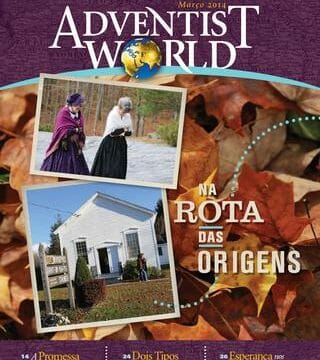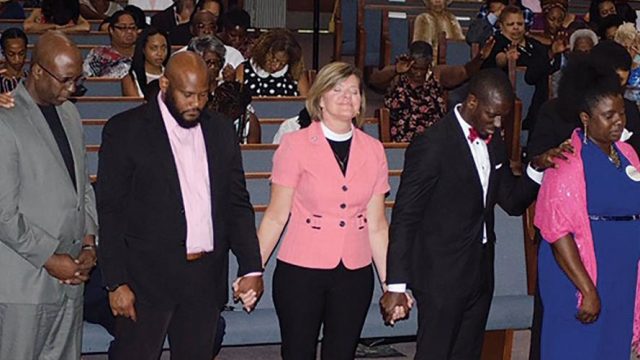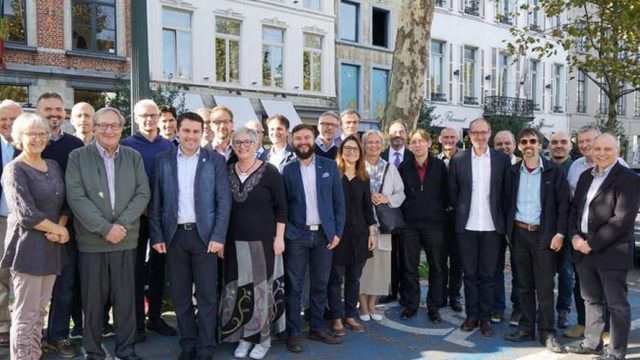U.S. Adventists are working across church regional lines to reach the whole reservation.

For the past five years, a group of lay and pastoral leaders of the Navajo Nation in the United States have been working across conference lines to develop an FM radio network known as Diné Adventist Radio (DAR) to share the Adventist message of hope, wholeness, and healing with the Navajo people, whose name for themselves is “Diné.”
The Navajo Nation is the largest Native American reservation with the largest indigenous population in North America, with territory that includes portions of four Seventh-day Adventist conferences in three union conferences. Most of the Navajo people follow traditional ways and are unreached by the Adventist message.
Since August 2020, a 30-minute weekly broadcast on the Navajo Tribal radio station has generated hundreds of Bible study requests and even led some individuals to baptism. These weekly programs are produced on a monthly rotation by Native-oriented Adventist congregations on and around the Navajo Reservation, including the Waterflow Seventh-day Adventist Church in Waterflow, New Mexico, and the LaVida Mission Seventh-day Adventist Church in Farmington, New Mexico. The goal is to be on the air across the Navajo Nation 24 hours a day, seven days a week.
The U.S. Federal Communications Commission (FCC) has already issued three full-power construction permits for stations that will cover much of the Navajo population, but there was a gap in the northeast section, the portion in the Rocky Mountain Conference (RMC). Last fall, the FCC announced they were opening a rare “application window” for low-power FM radio stations. These stations must be owned and operated by an incorporated, local nonprofit organization. According to FCC rules, Adventist churches don’t qualify as “local nonprofit” organizations because they are owned by the conference.
In response to this opportunity, members of the Waterflow and Farmington churches explored creative ways of applying for LPFM licenses. The Waterflow church already had a qualifying local nonprofit organization, and they used it to successfully apply for an LPFM station that will cover Shiprock, New Mexico, with a population of some 8,000 Native Americans. Waterflow church member Pam Goldtooth has offered to locate the tower on her tribal homesite lease — an ideal spot at the brow of a hill that overlooks the town.
A group of Farmington church members created a new nonprofit called Bisti Broadcasting and successfully applied for a low-power station to be located at the Piñon Hills Seventh-day Adventist Church in Farmington, New Mexico. “We are excited to engage in establishing radio programming to be broadcast from our Piñon church,” Karen Bowen, coordinator of the project, said.
Remarking on the local broadcasting project, Allen Steele, member of the Adventist World Radio board of directors and advisor to the Navajo Radio Network, said, “Members of two Rocky Mountain churches took this step so that the Navajo people in the Four Corners* can hear God’s last-day message.” When broadcasting begins in Farmington, it will reach some 12,000 Native American residents of the area.
Each group has three years to reach the point of being on the air, but they hope to accomplish this stage much sooner. The goal is to be broadcasting live and full time on KDHP 91.9 FM, the 100,000-watt flagship station at the heart of the reservation, by November 1, 2024, and then add other stations as soon as they are ready — including the Farmington and Shiprock stations.
The network is planned to include as many as seven stations plus worldwide streaming on the internet, reaching the majority of the Navajo Nation population. The network office and main studio will be located at the Gallup All Nations Seventh-day Adventist Church in Gallup, New Mexico.
The original version of this story was posted on the Rocky Mountain Conference news site.
______________________________
* Four Corners is the informal name of a region of the southwestern U.S. where the borders of four states (Arizona, Colorado, New Mexico, and Utah) meet with four corners.












